by Scott Smith | Contributing Editor
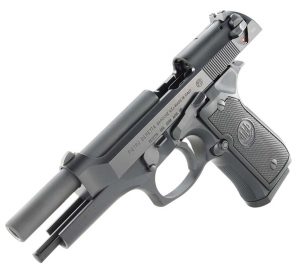
The classic Beretta 92FS/M9 with its slide locked to the rear.
Today the Beretta 92FS/M9 (Online: beretta.com) is the first and only pistol most service members have ever fired. The biggest reason is that unlike in decades past, Americans for the most part are not raised shooting firearms like they once were. To overcome this shortcoming troops are given more intensive basic firearms training and more comprehensive basic skills. They are qualified with their weapons during basic training, during their various military occupational skills training and at their units. Unlike in days gone by, the troops are now using scenario based firearms training and more man-on-man competitions, building much better basic/advanced firearms skills. We see the services fielding action shooting teams and their various marksmanship units using these action shooting skills training the troops. What this has done is create troops who have become action shooting competitors.
Many of these troops turn to a handgun they are familiar with as their first handgun for competition, the Beretta 92FS/M9, even when folks advise them to buy pistol brand XYZ. Many of the folks passing out this advice are diehard fans of brand XYZ or are part of the group who do not like Berettas because they are too big, they break, or they can never compete with the coolest new brand XYZ. Let’s take a look at these issues.
Back 30 years ago when the military initially adopted the 92FS/M9, so did a number of federal agencies, including Customs and Border Patrol (today ICE). The CBP was running +P and +P+ loads. These high pressures loads and increased slide velocities were cracking the locking blocks, frames and slides, causing the pistol to fail. CBP wanted these hotter loads for greater penetration so Beretta went back to the drawing board and developed the heavy Brigadier slide as well as improving the locking block. This increased mass and the better block stopped the cracking issue. This was the start of the myth that in some circles persists today, that Berettas are bad pistols that broke.
The locking block issue piggy backed onto the other “problem” of the 92FS/M9, the anemic 9mm cartridge. The hatred of the 9mm comes from the abysmal stopping power of the military issue full metal jacket round. In the eighties and even today, when shooting full metal jacket projectiles, the .45ACP is superior to the 9mm.
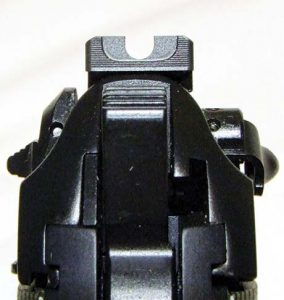
Wilson Combat’s Battlesight with its “U” notch for a fast accurate sight picture
On the upside, when the same Beretta is used for civilian law enforcement and personal protection, the 9mm is as an effective a man stopper, better than the vaunted .45ACP with less recoil and larger magazine capacity. This dramatic change is from the civilian sector’s ability to use modern hollowpoints that expand reliably and dramatically. If the troops were not constrained by The Hague Convention their Berettas would be just as effective as any 9mm in civilian hands. I am not going to argue the finer points of military law, other than to say this is one of the most quoted reasons the troops do not like the 92FS/M9.
Another problem with the Beretta developed during operations in Somalia and even during Desert Storm: poor feeding. This issue was quickly diagnosed to inferior magazines. With the deployment of troops during Desert Storm there was a need for more magazines than Beretta could provide and secondary market magazines were not up to specifications. This became a bigger issue when the troops were in Somalia and the 94 Crime Bill limited full magazine capacity production. Once these issues were diagnosed many magazines were retrofitted with new followers and springs which solved most of the issues. During the ensuing years and the sunsetting of the Crime Bill, military magazines were redesigned to keep excess dirt and grime out of them. Fifteen years of The Global War on Terror has shown us that the M9 is a fine pistol and functions in the harshest of conditions.
This reliability and consistent performance is why many of the troops and Veterans are purchasing 92FS/M9s for personal protection and even competition. With these privately owned pistols not being “issue” handguns, steps can be taken to correct the pistol’s shortcomings. Issues such as the large grip size, poor sights, and overall poor feel of the pistol can be corrected.
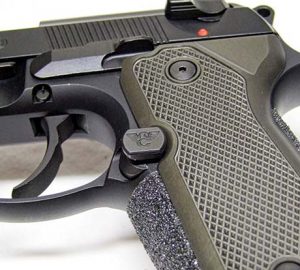
Pre refinishing 92G so you can see the OD green Aluma Grips and Wilson Combat Extended Magazine Release.
Many of our astute readers might ask: “Why would I want to improve a pistol ‘I hate’?” First this is a pistol many folks are familiar with. Second, the open slide of the pistol makes it nearly impossible to jam. One must have a reliable pistol to stake one’s life on and to perform well in competition. Next the “90” series of pistols offers several models to better fit the end user’s needs. This includes the 96 family chambered in .40S&W, the 92A1/96A1 which has a rail and heavy Brigadier slide, and there is the railed M9A1, the decocking only 92G (used in this article), the small-gripped 92 Vertec, the elusive 92G-SD, the new versatile M9A3 and compact versions of the 92. There are numerous holsters to fit the pistol allowing you to carry and use the pistol for competition or personal protection. After 30+ years of serving the military, finding spare parts is not an issue. Lastly and often overlooked, the 92FS/M9 also dominates on the competition field. It has won national and world titles in USPSA, IDPA, in 3Gun and today it is the service weapon of choice at Camp Perry and in inter/intra-service matches. This is why we need to see how to improve the base 92FS/M9.
The first and easiest change to make is the size of the grip. This is done by simply replacing the grips. To maintain their strength, the factory polymer grip panels can only be so thin. Aluma Grips (Online: alumagrips.com) are machined aluminum grips which by virtue of the metal’s strength reduce the overall grip diameter. Checkered Aluma Grips were installed on this 92G, with an MSRP of $74.95. Another huge advantage of these grips is the superior purchase on the pistol from the checkering, which reduces movement of the pistol during long strings of fire.
To further reduce the grip/reach on the pistol, a Wilson Combat Short Reach Trigger (Online: wilsoncombat.com) was installed. Yes, the folks who build some of the finest custom 1911s in the world also manufacture excellent parts to improve the Beretta 92. It turns out Bill Wilson is a devotee of the Beretta and has one of the largest private collections of Beretta pistols around. Wilson Combat collaborated with Ernie Langdon, the man who can make a 92FS run like it is a fully automatic 92R, to develop numerous parts for the 92FS/M9. Ernie has won numerous local, state and national championships, taught thousands of armed professionals and has carried a Beretta in harm’s way, so he knows how to make a Beretta run.
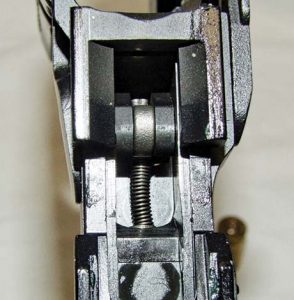
Close-up of the Wilson Combat Trigger Conversion Unit. This unit gives a smoother, lighter trigger pull.
The Wilson Combat Short Reach Trigger (SRT) is a drop-in part if you know how to properly strip a 92FS to its component parts. If you do not, Wilson Combat or any certified Beretta armorer can put the trigger in for you. The SRT changes the angle of the trigger so the bow sets further to the rear of the grip in both double and single action position. Once installed with Aluma Grips you will notice a big difference in the size of the grip and trigger reach. I found the overall reduction of the grip from the back strap around the trigger to be 3/16”, which in pistol terms is huge. While on the range locally, several shooters have shot my SRT-equipped 92G and all felt it was an improvement over the factory trigger/grip.
Another item installed when putting the SRT in was the Trigger Conversion Unit (TCU) sold by Wilson. This $19.95 plunger replaces the trigger spring ensuring the flimsy trigger spring will not break. This addition gives a smoother pull and, depending on the unit installed, a reduced trigger pull. When you are installing the SRT the TCU will fit onto the pin of the trigger bar. After installing the TCU on several 92 series pistols I would not run one in competition without it. This small part is so good and in such high demand it seems to be back ordered as fast as it comes in stock.
Because the 92 series of pistols is a working pistol designed for military and law enforcement, a nearly flush fit magazine release is standard. If you do not want to lose a magazine during operations this is a good idea, but if you need to change magazines in a hurry it is a problem. This issue was addressed with Wilson Combat’s Oversize Magazine Release. This magazine release is substantially larger than the OEM part, but it is not so large that you risk dumping the magazine accidently. With the twin plunger Beretta uses on the magazine catch, you still need to apply consistent pressure to the catch to change magazines. I have been using an extended Beretta magazine release, similar in size to the Wilson Combat part, that was factory standard on the Elite II version of a 92FS for several years. Even when moving through a three gun course of fire I have never accidently dumped a magazine. All a low profile extended magazine does is give you better access the magazine release. If you have a Beretta 92 that you plan to use for competition, spend the $41.95 on one; you will not regret it.
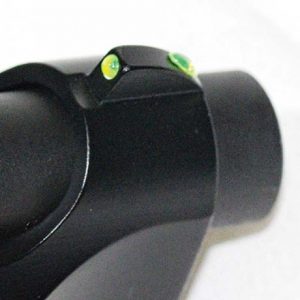
To reduce cost, Wilson Combat drills out the factory front sight and installs a fiber optic pipette to give the shooter a bright front sight.
The last part needed to make the Beretta a more shootable and accurate pistol is sights. While OEM sights are serviceable, they can be hard to see especially for those of us with, shall we say older eyes. Again Wilson Combat is the go-to vendor for the WC Battlesight. Like the other parts, this is a drop in replacement for the factory rear sight and a huge improvement over the OEM sight. With a .150” wide/deep “U-notch”, it is fast and accurate. The front ledge allows you to do one-handed manipulation of the slide if you have to. This $49.95 sight is a must have if you plan to truly make a 92 shine on the competition field.
To truly improve your 92FS, you need to contact Wilson Combat to have them install a fiber optic front sight. WC drills the factory sight and then slides in a fiber optic pipette. This is quicker and more cost effective than having the integral front sight milled off to cut a dovetail, and it does not reduce the strength of the slide. I have found this front sight modification to be an ingenious simple addition to my 92G.
The last few other modifications I made involved the installation of WC’s Mag Guide and to put anti-skid tape on the front strap of the frame. To some the $49.95 Mag Guide is an item that might not add anything to the pistol. I find it does allow for a quicker, smoother reload and it also keeps the pistol magazine off the deck if you are shooting prone. Anti-skid tape can be found at any home improvement store for just about a dollar a foot and will give you a solid grip surface. Because of the thin alloy frame, it is nearly impossible to texture or checker the front or rear straps of a Beretta.
Once I had all of the parts installed on my 92G it was off to the range to test out the pistol. For accuracy purposes I chose a few factory loads that I consider to be the most consistent and accurate on the market, Atlanta Arms 147-grain Elite Hollow Point (Online: atlantaarms.com), Black Hills Ammunition’s 124-grain XTP Hollow Point (Online: black-hills.com), Freedom Munitions 135-grain Remanufactured Hollow Point (Online: freedommunitions.com) and JJR Ammo’s 147-grain Full Metal Jacket (Online: jjramo.com). These four loads cover the use spectrum from personal defense/duty to competition and just good ole fashioned plinking. For those not familiar with these companies, Atlanta Arms, Freedom Munitions and JJR Ammo are used by many top performing 3Gun, IDPA and USPSA competitors. Black Hills Ammunition is used by competitive shooters across all the shooting sports and their ammunition is used by several specialized units in the military and law enforcement across the nation. Now back to testing the customized Beretta 92G.
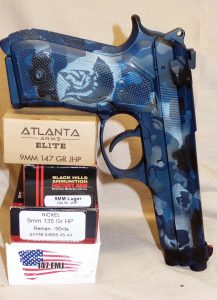
Author’s 92G with its test ammunition. You can see the Spartan from Montactical to make the pistol even more unique.
Prior to customizing the 92G it had been taken to the range and tested with these loads. As anticipated the pistol performed flawlessly. Accuracy wise it performed as expected and consistently fired sub 4-inch ten shot groups at 25 yards when shot offhand. When fired at 50 yards all rounds easily met the DOD requirement of keeping ten rounds inside a target 18 inches by 22 inches.
The trip to the range with the customized 92G proved that a pistol that fits the shooter’s hand and has sights that can be seen makes a huge difference. The 25-yard groups were all less than three inches with many rounds in each string of fire touching and at 50 yards the pistol was shooting six-inch ten-shot groups. With my well over 30 eyes, I will call that a huge success. Since the improvements easily eclipsed the military standard, I decided to shoot what the industry considers a standard: five shot groups at 25-yards. The pistol proved it could perform well with the average group hovering at 2½ inches; generally a couple rounds in each group touched.
What I found was my 92G did not show a preference for bullet weight or ojive type. This pistol was consistently accurate with all of our test ammunition. As expected, the 147-grain loads had the softest recoil, allowing for faster controlled pairs. This was only noticeable when I ran multiple shot drills with a timer and the actual split times could be seen. While this is only hundredths of a second on a course of fire, this adds up. I would run, and do run, Atlanta Arms, Freedom Munitions and JJR Ammo at matches and I do carry Black Hills XTP loads in my personal carry pistol. I can give no product higher praise than that.
After making the pistol shoot better, I had to make it look better. To give the 92G a true custom look, I turned to the folks at Lauer Weaponry and Duracoat (Online: lauerweaponry.com). A few shades of blue were chosen within the spectrum of those used in Naval Digital Camouflage, and “multicam” stencils were used to give the pistol a true custom finish. To really add a bit of flare I added a Spartan stencil from my buds at Montactical (Online: www.montactical.com).
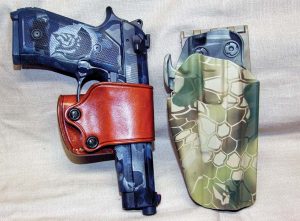
The 92G is resting in the simple Galco Yaqui Slide and Safariland’s GLS Pro Fit done in custom Kryptek by the author.
I briefly mentioned earlier that you can find holsters for the 92G and we did. Virtually every holster company in the business makes numerous holsters to fit Berettas. For my applications, this 92G will see time in a $55 Safariland GLS Pro Fit (Online: safarilan.com) or a Galco Yaqui Slide (Online: galcogunleather.com). The Pro Fit is one of the fastest security holsters I have used while the Yaqui Slide is just time proven simplicity. Both holsters will serve you well for competition and concealed carry.
After reading this I hope those of you who would like to use a Beretta 92 series pistol for competition will not shy away. Berettas are accurate, reliable and as you have read you can make one fit you. You just have to take some time to find the parts to make the pistol fit you need/want, but the work is worth it. After you do this, you will have a pistol to meet your needs that has proven itself all over the globe for the last 30-plus years.



